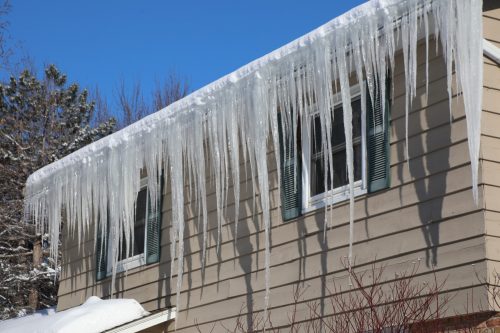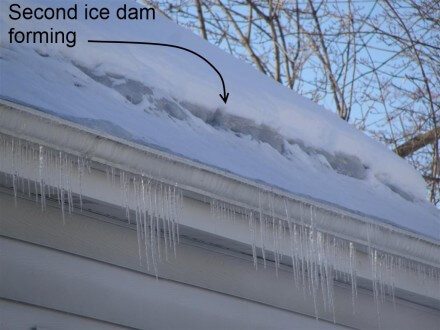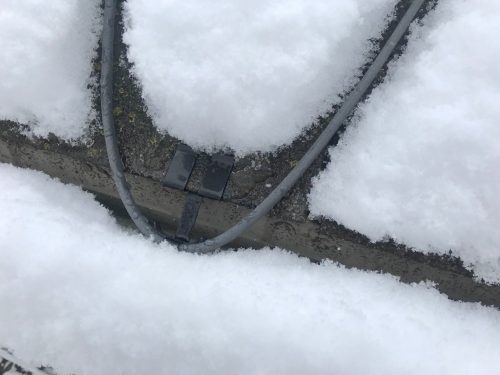This is a guest blog post by Steve Kuhl of Radiant Solutions Company.
Heat cable has a dubious reputation in the ice dam prevention world. It’s a topic few understand in-depth, both in terms of what it is and how to install it properly. In this three-part series, I will go deep into heat cable to provide clarity on what it is, where it works and doesn’t work, what to buy, what to avoid, and finally some tips on designing and installing your own heat cable system.
Background
The snowflakes in early October brought back bad memories of early 2019 for many Minnesotans. Impassable streets, flooded basements and of course, visions of nasty ice dams adorning homes both large and small. For those who are new to the area, an ice dam is a ridge of ice that accumulates on roofs, usually at the eave, that forces meltwater through the roof system and into your home. Think of them as mini glaciers that will ruin your house if you ignore them. Welcome to Minnesota!
While most insurance companies will pay to repair the damage left behind by ice dams they will NOT help pay for preventing them in the future, leaving many homeowners wondering how to avoid this troublesome and expensive problem. Making matters worse, some insurance companies are responding to ice dam claims by requiring homeowners to pay for expensive improvements aimed at preventing future ice dams. Without these improvements, future ice dam related claims may be denied.
Architectural solutions for ice dams
Industry pros recognize that the best solutions to ice dams involve making architectural enhancements to your home including insulation, ventilation and perhaps most important, sealing all of the air leaks that allow heat to go where it shouldn’t go and melt snow it shouldn’t melt. Remember, the resulting meltwater is what fuels the ice dam cycle as it refreezes along the eaves. Over the past quarter-century, we have engaged in hundreds of such home performance projects, with the average cost ranging between $10,000 and $30,000. The video clip below shows an example of the scope of this project.
These aren’t simple insulation and air-sealing jobs. This is hard, messy work that usually involves demolition and reconstruction of either the interior or exterior of the home or sometimes both. When it’s done well it can be called a valuable home improvement that will reduce the likelihood of ice dams while increasing energy efficiency. When it’s not done well it can be a waste of money that may even make ice dam problems worse. Bummer.
We all agree that architectural ice dam prevention methods are wonderful. In reality, however, many homeowners simply don’t have that sort of money in the budget. What’s more, I’ve seen dozens of ice dam cases where good intentions and ample budgets resulted in no meaningful improvement. This is why no roofing, remodeling or insulation company will ever guarantee in writing that their work will completely eliminate ice dams. It’s not realistic. For example, due to their design, it is almost impossible to insulate, ventilate and air-seal your way around ice dams if you live in a story-and-a-half home. Sorry, Saint Louis Park. Homes with a complex series of intersecting roof planes or vaulted ceilings with little-to-no room for insulation can make architectural solutions impractical if not impossible.
Roof shoveling for ice dam prevention
Roof shoveling can be an effective approach to ice dam prevention, assuming a few very important rules are followed. First, all of the snow must be removed from the entire roof plane affected by ice dams. Contrary to popular belief, removing the snow from the lower few feet of your roof can create a much worse situation known as a double-dam, which is the formation of a secondary ice dam higher on the roof.
Double dams are very expensive to remove and can cause tremendous damage if left unmitigated. On many homes, it’s not realistic to remove all of the snow up to the peak by roof raking from the ground or the top of a ladder because the affected roof planes may be two or three stories high or otherwise inaccessible.
This means someone has to climb up there, which is generally not a good idea for the novice to attempt. For many homes, the only option is to call in the pros, which is admittedly expensive. The video clip below shows some examples of professional snow removal.
The Ice Dam Company does a ton of snow removal here in Minnesota. Some clients choose annual contracts while others call after each significant snowfall. Our average roof shoveling job is $400 per visit, making professional roof shoveling an expensive approach to ice dam prevention, especially when we make multiple visits throughout the winter. Most people would get more satisfaction out of burning a pile of cash in their driveway than hiring us to shovel their roof all winter. I can’t blame them.
The other essential roof shoveling rule to follow is that all snow accumulations above 2” should be removed from the roof within 24 hours. Allowing snow to reside on a roof prone to ice dams has obvious consequences so you need to be vigilant with your roof rake. Under the right conditions, we see the process of ice dam formation start within one day of a fresh snowfall. The combination of all these factors means that many people get ice dams despite their good intentions to prevent them by roof raking. People get busy. People forget. Ice dams happen. Enter the humble heat cable.
Heat tape for ice dam prevention
It goes by many names, including heat cable, heat coil, and roof deicing cable, but the underlying principle of all ice dam prevention heat tape is the same. These cables use electrical resistance to generate warmth, creating melted pathways through the snow and ice on the roof. Those pathways allow water to escape from the roof instead of backing up into the home. The purpose of heat cable is ONLY to create relief channels through snow and ice, not to keep the eaves completely free of snow.
When a high-quality cable is used and it’s installed by someone who knows what they’re doing, heat cables can provide a decade of reliable ice dam prevention. In fact, there are circumstances when heat cables are the only realistic option for ice dam prevention. We run into these homes frequently in our inspections. Even still, there are industry holdouts who proclaim heat cables are ineffective. I think this owes to a lack of basic knowledge of the types of cables and the pros and cons each has to offer. Contributing to that ignorance is the fact that heat cables often fail, leaving behind water-damaged ceilings and disillusioned homeowners.
I’ve discussed the common approaches to ice dam prevention including architectural solutions, roof raking, and heat cable. Next week, in Part Two, I will explore heat cables in much greater depth, including their construction and use.






Rob C. Belles
November 5, 2019, 8:39 am
Comments on Solar panels and their “causing” or contributing to ice dams?
Peter Kennedy
December 17, 2019, 6:39 am
Greetings from Central Connecticut. This is a great, balanced overview of a topic area filled with myths and misinformation. After a bad winter several years ago, we decided to try ice cables, on the advice of our roof contractor. Our house is 60 years old, with some design quirks and a northern exposure — so we were good candidates. The cables have worked well. Key things, as stressed here in this article: 1. Professional installation. 2. Turn them on in advance of snow. It’s often too late if there’s 2-3 inches of snow already. 3.Turn them off when temperatures drop to the single digits. At that point they may be counterproductive. If installed correctly, with proper materials, you will get a lot of us out of them. I think for many they are a worthwhile investment. Good luck.